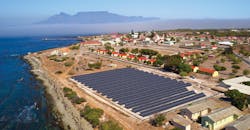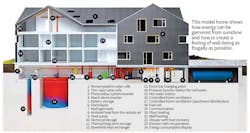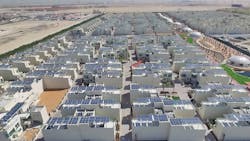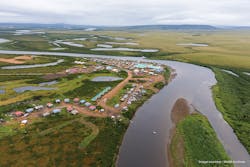There is a great deal of speculation about what the electric power grid will look like in the next 10 to 20 years. Hardly a week goes by without an announcement of a seminar, technical conference or webinar focused on visions of the future grid. This is good because the industry has already entered the transition. Now continuing the transition from today’s grid to the next generation is not going to be simple, as there are many issues that need to be dealt with, but the industry knows the future grid will be smart, dynamic, adaptive and driven by digital technologies.
In addition, the industry will have to address key elements that are critical when tinkering with the power system: advancing technology, changing economics, shifting regulations and the evolving sociological trends. These features are interconnected and changing any of them is disruptive, but modernizing the grid requires all four of them to be included for an evolution to occur. Fortunately, the founders of the power-delivery system, and those who followed them, designed a grid that is flexible and capable of change. It could be said that change is in the grid’s DNA.
For the most part, the grid has done a good job of meeting all the requirements placed on it, but today’s world is challenging the industry. The demands are larger in scale and happening faster than ever before. They are driven by megatrends, which have far-reaching effects on the grid in the crosshairs.
Remodeling the Grid
Eaton Corp. offers one of the best definitions of megatrends: "Megatrends are global changes in our economies and our lifestyles. They impact the way we live and do business today and will continue to do so in the coming decades." Eaton says that understanding these megatrends gives the industry "an edge in getting to the root of the customers’ needs."
It turns out several megatrends have been linked directly to shaping the future of the power sector. The list varies with the source being quoted, but most agree overall that the major trends are clean energy, renewable energy, distributed energy, energy storage and digitalization. Many of these are interrelated, such as clean energy linked to renewables and distributed energy linked to energy storage. If one looks deep enough, it becomes clear they are all interrelated with advanced technologies that make so much of this possible.
The legacy grid was designed for large centralized fossil-fuel generation plants continuously producing electricity. Nearly all the combustion by-products (carbon monoxide, carbon dioxide, sulfur dioxide, nitrogen oxides, particulate matter and heavy metals) from these plants have negative effects on the environment. With the public demanding cleaner energy, regulators put their weight behind the trend. Worldwide, regulators have issued orders requiring utilities to reduce emissions by specific amounts. Deadlines were defined and more sustainable (renewable) energy resources were required by a percentage of the total generation capacity, and it is working.
According to the Energy Information Administration (EIA), coal-fired generation accounted for almost 50% of the generation mix in 2007. Ten years later, coal dropped to about 30% of the total generation. This trend is reshaping the power-delivery system. EIA noted retirements of coal-fired power plants have accelerated, many of which are some of the oldest resources on the grid.
Interrelated with this trend line is the growth in renewable energy. Globally, the amount of renewable generation has exploded exponentially because of a great deal of effort to encourage the growth of renewables. Governments have given tax credits and preferential treatment, while customers have added renewable resources to their homes and businesses.
Utilities also have deployed solar and wind farms to meet regulatory requirements. Consequently, renewables have become the fastest-growing segment of the electric grid. The International Energy Agency (IEA) says almost 165 GW of photovoltaic (PV) generation came on-line in 2016, which is almost two-thirds of the net new power capacity around the world. IEA predicts more than 920 GW of capacity will be added to the global grid by 2022. This figure represents about 43% of today’s capacity. To put this in a more tangible form, the World Economic Forum reported, "The amount of solar power capacity expected to be added in the coming years is equivalent to 70,000 new solar panels every hour."
In 2011, the U.S. Department of Energy (DOE) launched the SunShot initiative to help reduce the cost of PV installations by 75% by 2020. The DOE reported, "Last September, the DOE’s National Renewable Energy Laboratory had achieved its utility-scale PV goal of $0.06/kWh three years earlier than expected. (Residential and commercial solar costs have also come down, to $0.16 and $0.11, respectively. That’s well on the way to the 2020 targets of $0.10 and $0.08, respectively.)"
As prices come down, renewable energy resources are defining the 21st century grid and changing the interface between the transmission system and distribution network.
Prosumer Power
This boundary change is redefining the next generation of the power-delivery system, too. The quest for clean energy has led the industry to renewable energy. This has provided a much-needed boost for distributed energy resources (DER) technology. DER has moved from being a limited-interest technology to the mainstream of the grid.
DER has benefited from the need for clean energy and growth of renewables in one unexpected way: When residential, commercial and industrial customers embraced PV and small wind-turbine technologies, they started a new force that is redefining the business model for power supplier and power consumer. According to HIS Markit, "By 2020, more than 25 TWh of electricity will be generated and self-consumed on-site in Germany, Italy and the United Kingdom, in aggregate."
In Brütten, Switzerland, the first energy-autarkic apartment building was built by Umwelt Areana Spreitenbach in partnership with ABB. Nine families are taking part in the 100% energy self-sufficient housing. The building has solar panels covering the roof and façade generating direct current (DC), which is converted to alternating current (AC) for household use by ABB solar inverters. According to a spokesperson, one hour of sunshine in the summer is enough to supply the power needs of the building’s occupants for an entire day. The excess electricity is stored in batteries for later use.
The United Arab Emirates is harnessing the power of the sun in Dubai’s first all-electric city, referred to as The Sustainable City. ABB supplied 400 DC-to-AC inverters for 400 villas. The city will be the region’s first fully sustainable community, housing roughly 2000 residents within an area of approximately 500,000 sq m (124 acres) when completed. A spokesperson said, "The panels and inverters will ultimately generate 10 MW-peak of power on private and public buildings within the city."
Projects like these are giving the industry a sneak peek at the next-generation grid. Because of this trend and with the support of regulators, utilities no longer have a monopoly on generating power. The one-way relationship from the utility to the customer has changed.
Changes in regulations have created economic incentives for prosumers to own and operate their own power system. According to a DOE report, the grid is no longer a delivery pipe for supplying power to the customer. Instead, power is flowing both ways as prosumer technologies are becoming ubiquitous. Prosumer technology is making the grid the hub of a more open and competitive market.
Microgrids and Storage
Initially these microgrid technologies started out as small devices placed on the customer’s side of the meter to keep the lights on or to reduce the electric bill. Microgrid technologies have advanced over the years and morphed into a wide array of digital technologies now referred to as DER systems. What once was described as a behind-the-meter or an edge-of-the-grid technology is moving into the mainstream of the power-delivery system. They include generation devices, renewable energy sources, monitoring systems, control schemes, microgrids and energy storage systems, which enable greater real-time responsiveness, when needed.
The future grid will have more DER systems that vary in size and are located throughout the entire grid. Two associated technologies — microgrid and energy storage — are an important part of the DER family and will have an expanded role in the future grid.
Microgrids drew global attention when Superstorm Sandy brought extensive power outages to the northeastern U.S. At the same time, people noticed islands of light powered by microgrids in otherwise dark cities. When the monster hurricanes of 2017 hit Texas, Florida and Puerto Rico, once again loads protected by microgrids stayed energized. However, this time more microgrids were deployed, demonstrating the technology is dependable. Microgrids have been defined as smaller-scale forms of the power grid that include distributed generation, advanced control systems, islanding capabilities and energy storage facilities.
One of the latest applications of advanced microgrid technology is found powering the World Heritage site on Robben Island off the coast of Cape Town, South Africa. The microgrid combines PV panels, batteries and wireless technologies to reduce the island’s reliance on diesel generators and reduce carbon emissions. The project was funded by the Department of Tourism in South Africa and executed for SOLA Future Energy.
The microgrid consists of a 667-kW-peak solar farm, an ABB inverter system, an 837-kW ABB Ability PowerStore battery energy storage system, diesel backup and a dedicated ABB Microgrid Plus control system, whose internet cloud-based capabilities make remote operation possible. The control system enables management of the power supply, including energy storage, while balancing the use of renewable energy and diesel backup based on changing demand.
Claudio Facchin, president of ABB’s Power Grids division, said, "The project supports our focus on microgrids and our ongoing commitment to reduce environmental impact as a partner of choice for enabling a stronger, smarter and greener grid."
Two villages north of the Arctic Circle — Deering and Buckland, Alaska, U.S. — rely on electricity generated by diesel generators. Winter lasts for nine months, with temperatures dipping to -60°F (-51°C). The local utility, NANA Regional Corp., set a goal to reduce the cost and environmental impact of using diesel fuel by replacing it with microgrids powered by wind generation. The flat coastal terrain is suited for wind generation; however, wind turbines installed there have been underused because of the intermittent and unstable nature of wind power.
ABB will partner with the communities of Deering and Buckland to install advanced modular plug-and-play microgrids. These devices will leverage the proven ABB Ability Microgrid Plus automation system and PowerStore battery storage systems to maximize the adoption of wind power. Incorporating more renewables also will help the communities to lower costs and support the environmental objectives set out by NANA.
Microgrids and energy storage technologies fit snugly into the overall DER technology that has made power a bidirectional process and is redesigning the business model of the future grid. Navigant Research predicted, "The global market for DER digital energy products and services will create $1.3 billion in new revenue opportunities globally."
In addition, Navigant stated, "New DER capacity from distributed generation, energy storage, energy efficiency, demand response, microgrids and electric vehicles is expected to grow three to five times faster than new central station generation in the next 10 years."
HVDC Grid
Another trend gaining support from experts is poised to reshape the power grid as never before: the proposal to develop a mega grid. The mega grid is a large-scale power grid combining AC and high-voltage direct-current (HVDC) technologies to make a more efficient system for moving large blocks of power over great distances. The AC power grid will integrate an over-grid of HVDC multiterminal hubs to form an HVDC network. This idea has been around a long time but only recently has the technology been available to make this concept a reality.
In a recent news release, Zhang Jinquan, senior vice president of ABB Group and head of the Power Grids division in China, said, "Power grids are experiencing an unprecedented revolution worldwide. Renewable energy, energy connectivity and digital technologies will play key roles in this process."
Zhang also stated, "A clear vision and the need for greater collaboration across stakeholders, including policy makers, regulators, utilities and technology providers, are key success factors to facilitate sustainable energy development and enabling a stronger, smarter and greener grid."
The future power grid will have a great deal of renewable energy generation incorporated into it. Unfortunately, these large renewable generation facilities usually are far removed from load centers needing the clean energy. An HVDC transmission grid enables the mega grid to move large amounts of renewable energy independent of the AC grid.
Technology Trends
In addition to the megatrends sweeping the globe, an abundance of newly available enabling technologies are changing the power-delivery system. It all started as a modernization effort for the grid deploying smart grid technology. Like all technology, smart grid has matured and advanced into what many refer to as smarter grid technology.
Thinking back, smart grid technology began with a lot of discussion about transforming the industry from analog based to a modernized digital scheme. This would be the mechanism to move us from the 20th century to the 21st century. It took a while, but today there is not a single component on the grid that has not been enhanced, enriched or augmented by some form of embedded digital wizardry.
However, the challenge has been the ability to integrate all these elements into a total digital power-delivery system and make them work together seamlessly within a demanding environment. Technology has been helping with this task. The grid is totally interconnected by digital technology such as the Internet of Things (IoT). In fact, the smart grid has been referred to as IoT in action.
Taking this theme further, several industry experts have referred to the Utility Internet of Things (UIoT). UIoT technology takes interconnectivity to a new level. It has been described as a bridge between information technology and operational technology to link the utility’s entire enterprise.
Grid in Transition
Today’s electricity delivery system is a grid in transition, moving from an assortment of old-school technologies to a modern digitally interconnected intelligent network. Today’s grid demands high-quality power. It needs to be a more autonomous network driven by IoT and DER technologies, and tomorrow’s grid will be more so in every aspect. The present grid is shifting from a demand-driven system to a bidirectional energy system, and tomorrow’s power grid will make this seem primitive.
The next-generation power grid is being transformed by many new digital technologies, but this modernization is more than any one technology. The transition from the power grid of today to the grid of tomorrow will be as overwhelming as all the advances in power systems over the last 100 years combined, but it will take place in a fraction of the time. The technology is available, it is maturing and it is changing. These technologies are forming the foundation of tomorrow’s power grid and creating an opportunity for the electric utility industry to stretch its creative muscles. ♦
About the Author
Gene Wolf
Technical Editor
Gene Wolf has been designing and building substations and other high technology facilities for over 32 years. He received his BSEE from Wichita State University. He received his MSEE from New Mexico State University. He is a registered professional engineer in the states of California and New Mexico. He started his career as a substation engineer for Kansas Gas and Electric, retired as the Principal Engineer of Stations for Public Service Company of New Mexico recently, and founded Lone Wolf Engineering, LLC an engineering consulting company.
Gene is widely recognized as a technical leader in the electric power industry. Gene is a fellow of the IEEE. He is the former Chairman of the IEEE PES T&D Committee. He has held the position of the Chairman of the HVDC & FACTS Subcommittee and membership in many T&D working groups. Gene is also active in renewable energy. He sponsored the formation of the “Integration of Renewable Energy into the Transmission & Distribution Grids” subcommittee and the “Intelligent Grid Transmission and Distribution” subcommittee within the Transmission and Distribution committee.



